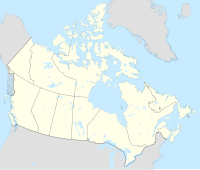Fort Qu'Appelle | |
|---|---|
| Town of Fort Qu'Appelle | |
 1897 Hudson's Bay Company store in Fort Qu'Appelle, Saskatchewan | |
| Nickname: "the Fort" | |
| Coordinates: 50°45′56″N 103°47′25″W / 50.76556°N 103.79028°W | |
| Country | Canada |
| Province | Saskatchewan |
| Rural Municipality | North Qu'Appelle |
| Post office Founded | 1880 |
| Incorporated (town) | 1951 |
| Government | |
| • Governing body | Fort Qu'Appelle Town Council |
| • Mayor | Gus Lagace[1] |
| • Administrator | Cheryl Martens |
| Area | |
• Total | 5.28 km2 (2.04 sq mi) |
| Population (2006) | |
• Total | 1,919 |
| • Density | 363.2/km2 (941/sq mi) |
| Time zone | CST |
| Postal code | S0G 1S0 |
| Area code | 306 |
| Waterways | Qu'Appelle River |
| Website | Fort Qu'Appelle, Saskatchewan |
| Official name | Fort Qu'Appelle National Historic Site of Canada |
| Designated | 1953 |
Fort Qu'Appelle (/kəˈpɛl/) is a town in the Canadian province of Saskatchewan located in the Qu'Appelle River valley 70 km (43 mi) north-east of Regina, between Echo and Mission Lakes of the Fishing Lakes.[2] It is not to be confused with the once-significant nearby town of Qu'Appelle. It was originally established in 1864 as a Hudson's Bay Company trading post. Fort Qu'Appelle, with its 1,919 residents in 2006, is at the junction of Highway 35, Highway 10, Highway 22, Highway 56, and Highway 215.[3] The 1897 Hudson's Bay Company store, 1911 Grand Trunk Pacific Railway station, Fort Qu'Appelle Sanatorium (Fort San), and the Treaty 4 Governance Centre in the shape of a teepee are all landmarks of this community.[4] Additionally, the Noel Pinay sculpture of a man praying commemorates a burial ground, is a life-sized statue in a park beside Segwun Avenue.[5]
- ^ Council & Staff
- ^ McLennan, David. "Fort Qu'Appelle". Encyclopedia of Saskatchewan. Retrieved 18 June 2012.
- ^ "Fort Qu'Appelle, SK". Google Maps. Retrieved 12 August 2007.
- ^ McLennan, David (2006). "Fort Qu'Appelle". The Encyclopedia of Saskatchewan. CANADIAN PLAINS RESEARCH CENTER, UNIVERSITY OF REGINA. Retrieved 15 April 2008.
- ^ Redekopp, Dale (1999–2006). "Praying Indian Fort Qu'Appelle, Saskatchewan". LARGE CANADIAN ROADSIDE ATTRACTIONS. Archived from the original on 9 November 2007. Retrieved 15 February 2008.

